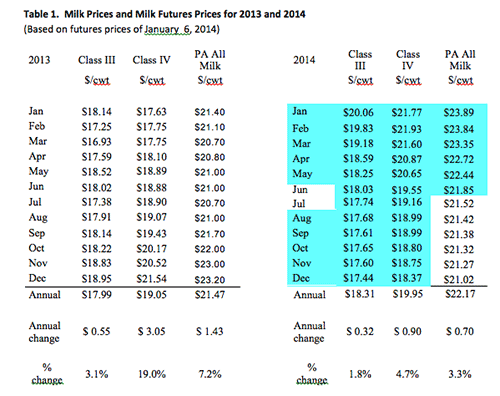
By Jim Dunn, Professor of Agricultural Economics, Penn State University
Market Psychology
The CME block cheese price rose by 9.5% in the last month, ending 18¢/lb. higher at $2.05/lb. Cheese prices have risen steadily since mid-November. This increase is driven by export demand, especially from China. CME butter prices fell by 2.4%, or 4¢/lb. in the past month. The butter price showed weakness in the middle of December, but has regained much of these losses. The latest butter production report had sizeable decreases in November, supporting what is generally a weaker market. Skim milk powder continues to rise, increasing another 4.3% since last month. The increased export demand is supporting the powder price, so that prices are strong, despite increased inventories. Dry whey prices rose 2% to $0.5625/lb. Like skim milk powder, the increased production has been matched by demand, so for now the market is absorbing these production increases without lower prices.
Table 1 lists some past and estimated future milk prices. The December Pennsylvania all-milk price was $0.20 higher than the revised November value at $23.20/cwt. The sizeable revision of the November all-milk price put the PA all-milk price above $23.00 for the first time since November 2012, and with December, the first time the all-milk price has been above $23 in consecutive months since September 2011. Those past prices were accompanied by higher feed prices, so the present price is better once costs are considered. The December Class III price was $0.12 higher than in November at $18.95/cwt. The Class III futures price for January is $20.06. Average Class III futures prices for 2014 are up $0.32 above the average 2013 prices at $18.31. Like last month, a small increase in the latest milk production report along with strong cheese futures prices make the higher cheese prices sustainable, especially for early 2014. The December Class IV price was up $1.02/cwt. from November at $21.54/cwt. The prices of Class IV futures average $19.95/cwt. for 2014, up significantly from the 2014 futures prices of last month. The first few months are especially strong, with weaker Class IV futures as 2014 progresses. The PA all-milk prices for 2013 and the forecast prices for 2014 based on the futures prices are also shown in Table 1. The forecast all-milk prices for 2014 average $0.70/cwt. above the average for 2013, which given the lower feed prices is positive for dairy farmers.
The U.S. dollar is higher in the past month against the Australian and New Zealand dollars and the Euro. The Australian is 2% lower, the Euro 1% lower, and the New Zealand dollar 0.3% lower. These exchange rates will hurt our export competitiveness slightly.
Corn and Soybean Markets
Corn has remained low, trading in a narrow range between $4.20/and $4.40/bu. for the March contract since mid-November. Soybeans and soybean meal have fallen since mid-December highs, with beans down about 50¢/bu. March beans are at $12.72.bu. and March soybean meal at $14/ton. The Chinese concern about Genetically Modified Organisms (GMOs) is a recent concern in export markets. Whether this is an accurate reflection of consumer attitudes or a government method of protecting domestic producers in unclear, but this is potentially a problem since China is a very big customer. Given the overall state of food safety in China, GMOs would appear to be the least of their problems. It appears that Brazil and Argentina will have very good corn and soybean crops. This is increased competition for our exports. South American competition has been strong for soybeans for many years, and the soybean futures prices are lower for the May contract than for the March contract and the March contract than for the January contract. These negative returns to storage are recognition of the importance of the Southern Hemisphere production. We could see the same thing in the corn futures market in coming years, which would change corn storage practices.
Income over Feed Costs (IOFC)
Penn State's measure of income over feed costs rose by 0.4% in December. This is an increase of 4¢/cow/day. The December value is $10.29/cow/day, the highest value since 2007. The increase in December is because of a higher milk price, which rose by 0.9% from November levels. Feed prices rose by 1.9%, because of a small increase in the corn price. The cost of feeding a cow rose by 9¢/day to $4.79. Income over feed cost reflects daily gross milk income less feed costs for an average cow producing 65 pounds of milk per day. Figure 1 and Table 2 showing the monthly data are appended.
The allocation of the revenue per hundred pounds of milk is shown in Table 3. The milk margin is the estimated amount from the Pennsylvania all milk price that remains after feed costs are paid. As does income over feed cost, this measure shows that the December PA milk margin was 0.4% higher than October.
Milk Production
As can be seen in Figure 2, milk production for November was 0.1% more than the previous year. This was a smaller increase relative to a year earlier than October. Given the improvement in profitability, this increase is a very small. The number of dairy cows is shown in Figure 3. The November cow numbers are slightly below November 2012. Cow numbers have decreased a bit for the last three months, which is significant. The improvements is dairy margins have not prompted an increase in cow numbers. In particular, western producers are not adding cows, despite better margins. The last couple years have especially hurt producers who buy most of their feed.







1.7.2014